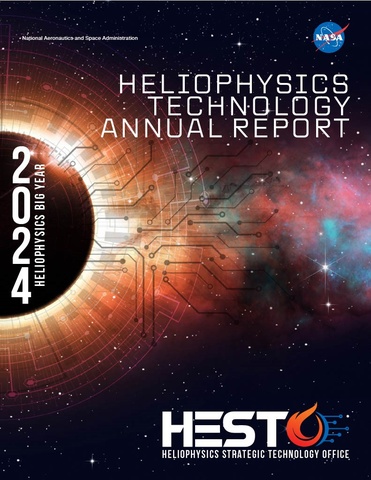
The inaugural Pathfinder Project led by University of Iowa Physics and Astronomy researcher David Miles is among the projects featured in a recent report from NASA’s HEliophysics Strategic Technology Office (HESTO).
The 2024 NASA Heliophysics Technology Annual Report highlights HESTO’s ongoing Heliophysics Technology investments, including those awarded under our Heliophysics Technology and Instrument Development for Science (H-TIDeS) and Heliophysics Flight Opportunities Studies (H-FOS) program.
Dr. Miles, an F. Wendell Miller Associate Professor at the UI, is Principal Investigator for the inaugural HESTO Pathfinder project, which plays a critical role in advancing heliophysics technologies across the gap from early-stage development to flight readiness. It provides a structured pathway for promising instruments and technologies to progress beyond the proof-of-concept stage toward integration into larger heliophysics science missions. Pathfinder focuses on maturing technologies for potential infusion into larger missions, such as Explorers-class missions. By promoting technology flight demonstration through rideshare access, Pathfinder leverages cost-effective validation of highly promising technologies in relevant operational environments.
This initiative builds upon advancements made through NASA’s Heliophysics Technology and Instrument Development for Science (H-TIDeS) program. Pathfinder funding is awarded to PIs who secure their own rideshare opportunities, focusing Pathfinder funds on technology maturation rather than flight costs. This approach is cost-effective while maximizing the potential for successful technology infusion into future Heliophysics missions.
HESTO Pathfinder reached a significant milestone by funding its first project: Space Weather Iowa Instrument (SWIM). SWIM is a magnetometer gradiometer instrument that integrates four innovative technologies, two of which were developed through previous HESTO-funded projects.
1. MAGnetometers for Innovation and Capability (MAGIC) – This technology demonstration incorporates newly developed ferromagnetic materials into a compact fluxgate sensor, adapting the Tesseract sensor design that will shortly fly on the TRACERS satellite mission.
2. Chimera Hybrid Magnetometer – Utilizing digital signal processing and demodulation, this instrument shifts key magnetometer functions from analog electronics to field-programmable gate array-based digital processing and was test-flown on the ACES-II suborbital rocket mission.
3. Advanced Digital Magnetic Feedback – A digital magnetic feedback topology, developed by the PI, that provides high measurement stability use in low magnetic fields like future solar wind monitoring and lunar lander payloads.
4. Radiation-Tolerant Design – Prototypes critical instrument subsystems using high-fidelity engineering-grade components, demonstrating functionality in a 100 krad-tolerant design, suitable for long-duration use in hostile space environments.
Dr. Miles secured a flight opportunity aboard the Investigation of Cusp Irregularities-5 (ICI-5bis) sounding rocket flight campaign, launching from Andøya Space, Norway. By supporting projects like SWIM, HESTO Pathfinder aims to drive innovation in Heliophysics, ensuring novel technologies are ready for infusion into science missions and to contribute to future discoveries.
Other University of Iowa projects noted in the report include:
- LOBSTR: LabOratory for the Behavior of the SloT Region. Rachael Filwett, a former postdoctoral researcher at the University of Iowa and now Assistant Professor at Montana State University, is the principal investigator for this mission where SmallSats battle radiation to provide insights into the Earth's radiation belts. Miles and UI Associate Professor Allison Jaynes, an F. Wendell Miller Associate Professor, are co-investigators on this project and are representing the magnetometer and energetic particle instruments.
- CHIMERA: Hybrid Magnetometer for Smallsats. Miles is also the PI for this project, which will combine search coil and fluxgate magnetometers into one package. CHIMERA is a hybrid magnetometer that operates simultaneously as a search coil magnetometer and as a fluxgate magnetometer, offering improved operational flexibility compared to conventional two-instrument approaches.
Dr. Miles serves on the committee for the Heliophysics Technology Program Analysis Group (H-TPAG), a community-based interdisciplinary forum for soliciting and coordinating community analysis and input in support of Heliophysics Technology Program (HTP) objectives.
NASA established HESTO in 2020 to support and manage its Heliophysics Technology Program (HTP). Hosted at NASA Goddard Space Flight Center’s Wallops Flight Facility (WFF), HESTO is tasked with facilitating HTP investments, nurturing project maturation, and promoting technology infusion toward furthering the greatest benefit to the science community.
